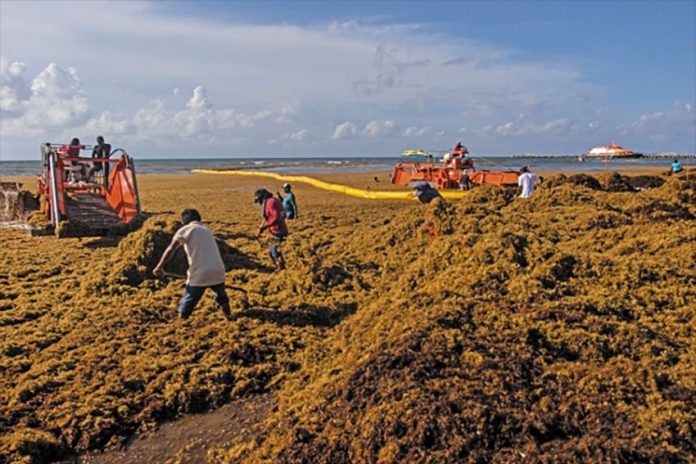A Michoacán company that is already using the nopal, or prickly pear cactus, to produce biogas is now planning to do the same with sargassum, a genus of seaweed that washes up on Caribbean coast beaches in large quantities.
Nopalimex, a Zitácuaro-based firm that in 2019 opened Mexico’s first nopal biogas plant, has already proved that sargassum can be converted into biogas and is now seeking a patent for its process. It is also preparing to open a plant in Quintana Roo, the state most affected by the seaweed during the annual sargassum season.
In an interview with the Milenio newspaper, Nopalimex’s technical director said that trials in 2019 demonstrated that raw biogas with a methane content of up to 72% can be produced from sargassum.
“We found that the [methane] content … is very acceptable, … which makes [sargassum biogas] ideal for energy generation,” said Miguel Aké Madera, an electrical engineer.
He said that biogas obtained from both sargassum and nopal has a methane content in the 64-72% range, whereas that obtained from avocado waste is in the 64-79% range. Another Michoacán-based company partly owned by Nopalimex’s owner produces biogas from avocado seeds and skins.
Aké explained that biogas is obtained from sargassum via anaerobic digestion. After the seaweed is cleaned of sand and salt it is fed into a hermetically sealed biodigester, where the biogas is produced via a process in which microorganisms break down the sargassum in the absence of oxygen. The gas is produced in a period of three to four weeks, Aké explained.
With its 64-72% methane content, the raw biogas “can be used directly in boilers, in hotel boilers for example,” he said.
To generate electricity from the gas, “you have to clean it in such a way that the methane content is at least 75% so that it doesn’t damage the motor of the electrical generator,” Aké added.
To use sargassum biogas as vehicle fuel, an additional cleaning process is needed in order to increase the methane content to 96% or 97%, he said. “Hydrogen sulfide disappears completely and a 1% content of carbon dioxide and other particles such as hydrogen and oxygen remains, but they’re not contaminating elements,” Aké said.
He said that 100 cubic meters of biogas can be produced from 1 tonne of sargassum, which has also been used to make bricks and paper.
In the Quintana Roo municipality of Felipe Carillo Puerto, Nopalimex intends to install a biodigester into which 150 tonnes of sargassum per day will be fed, Aké said. “It will yield 15,000 cubic meters [of biogas] per day,” he said.
Aké said that Nopalimex already has a site where it intends to install its sargassum processing plant but will wait to hold talks with the new Quintana Roo government – which takes office later this month – before moving ahead with the project.

The engineer predicted that sargassum biogas can be produced for just 3 pesos per cubic meter, a cost that takes the expense of collecting and transporting the seaweed into account.
“LP gas costs about 13 pesos per liter so there is a big difference,” Aké said, adding that sargassum gas could be sold to hotels at a good price. “But what I see as most important is the environmental benefit this [gas] will bring,” he said.
Aké doesn’t envisage that the supply of sargassum will be a problem considering the large quantities that have washed up on Quintana Roo beaches in the past months – and in recent years. He said that collecting sargassum and using it to produce biogas will help to alleviate an environmental problem given that the seaweed contains heavy metals such as mercury, lead and arsenic.
One person eagerly awaiting Nopalimex’s commencement of operations in Quintana Roo is Arturo Tapia, owner of a company that converts vehicles’ engines so that they can run on natural gas and biogas.
Tapia, owner of Kawil Energéticos and an investor in Nopalimex’s Quintana Roo project, said that sargassum biogas plants could eventually be built in other municipalities in the Caribbean coast state. He explained that his company can convert vehicles to allow them to run on LP gas or biogas at a cost of about 30,000 to 38,000 pesos (US $1,500 to $1,900).
“We have the capacity to convert all the [tourism-oriented] vehicles in the hotel zone,” Tapia said. “And we [will] have the capacity to supply them with [sargassum] biogas,” he said.
With reports from Milenio
